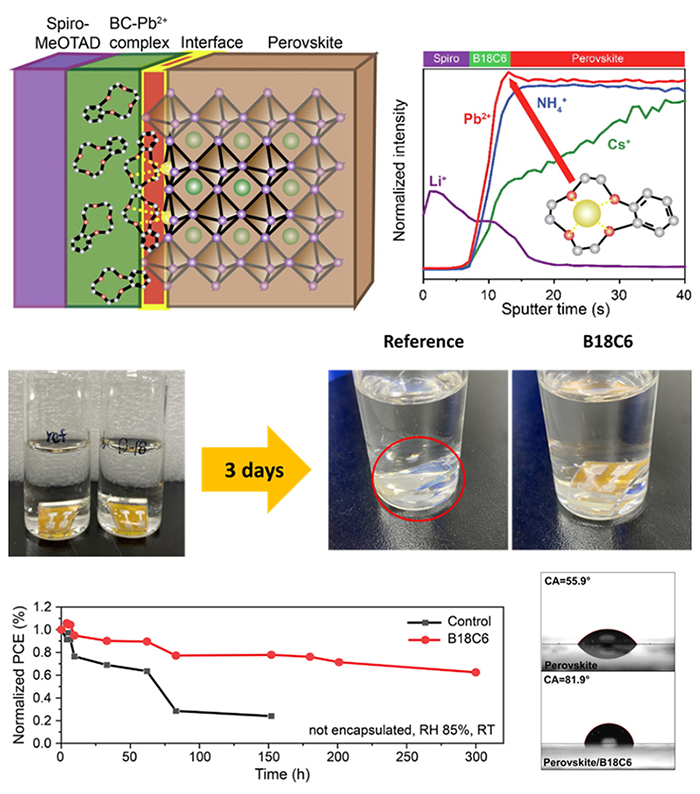- 게시일자
- 조회수
- 58
[PNU리서치] 서지연 교수팀, 꿈의 소재 '페로브스카이트' 안정성·납 유출 우려?
크라운 에테르 공정으로 효율·안전 동시 해결해 상용화 촉진 기대
미래 신소재로 주목받고 있지만 미흡한 장기 구동안정성과 납 유출 문제로 활용이 지체돼 온 ‘고효율 페로브스카이트 태양전지’의 안전성(Safety)과 안정성(Stability)을 동시에 해결할 수 있는 새로운 기술이 개발됐다.
우수한 광전자 특성을 지닌 페로브스카이트 태양전지는 차세대 에너지원으로 큰 관심을 모으고 있다. 하지만, 상용화에 적합한 높은 전력 변환을 달성하고도 디바이스 안정성이 좋지 못해 이를 해결하는 것이 주요 과제로 남았다. 또한 페로브스카이트 광활성층에 사용되는 납 성분의 독성은 환경에 부정적인 영향을 미치며, 특히 수분이 페로브스카이트의 상 분해를 유도해 납 누출을 증가시킬 수 있다는 점도 적극적인 활용에 걸림돌이 돼 왔다.
이에, 나노에너지공학과 서지연(사진) 교수 연구팀은 새롭게 개발한 납 포획 기술을 통해 납을 효율적으로 포획해 태양전지 모듈이 손상을 입어 외부에 노출되더라도 납을 고정함으로써 누출을 방지할 수 있도록 했다. 계면(界面)의 결함을 효율적으로 치유해 태양전지 광전변환 효율도 향상시켰다.

【크라운 에테르 물질의 효율적인 납 포획 기능과 태양전지의 장기 수분안정성 향상】
연구팀은 벤조-18-크라운-6 에테르(Benzo-18-crown-6 ether)와 같은 크라운 에테르(crown ether, 고리형 폴리에테르) 물질을 이용한 간단한 용액 공정을 통해 납-할라이드 페로브스카이트의 계면 패시베이션(Interfacial passivation)*을 시도했다.
* 계면 패시베이션((Interfacial passivation): 물리적 또는 화학적 방법을 사용해 물질의 표면 또는 계면을 안정화시키는 과정.
그 결과 전력 변환 효율의 증가를 달성해 계면 패시베이션의 효능이 강조됐고, 크라운 에테르가 납 이온과의 호스트-게스트(host-guest) 복합체* 형성을 통해 납 누출을 저지할 뿐만 아니라, 계면 처리한 필름은 수분에 대한 강한 저항성을 가져 높은 습도 환경에서도 기존 대비 향상된 장기 안정성을 보임을 확인했다.
**호스트-게스트(host-guest) 복합체: 호스트 분자가 일종의 컨테이너 역할을 하고, 게스트 분자는 호스트 분자 내부에 들어가거나 호스트 분자의 표면에 결합해 형성된 안정된 복합체.
이는 상용화 및 신재생 에너지 응용을 발전시킬 준비가 된 지속가능한 페로브스카이트 태양전지에 대한 납 누출 및 장기 안정성을 동시에 해결하는 크라운 에테르의 가능성을 보여준 것이다.
서지연 교수는 “이번 연구결과를 통해 페로브스카이트 태양전지 활용에 발목을 잡고 있는 안정성과 안전성을 동시에 해결해 상용화를 촉진시킬 수 있을 것으로 기대한다”고 말했다.

【제1저자 김선주 석박사통합과정생】
이번 연구는 한국연구재단 기본연구사업과 산업통상자원부, 한국산업기술진흥원의 국제공동기술개발사업 지원을 받아 부산대 BK21 에너지융합기술교육연구단 소속 석박통합과정생 김선주 학생이 제1저자, 나노에너지공학과 서지연 교수가 교신저자로 수행했다. 스위스 로잔연방공대학(EPFL) Kevin Sivula 교수팀, 스위스 프리브룩대학(University of Fribourg) Jovana Milic 교수도 참여했다.
해당 논문은 국제 학술지 『Journal of Energy Chemistry』 5월호에 게재됐다.
- 논문 제목: Interfacial engineering through lead binding using crown ethers in perovskite solar cells(크라운 에테르를 이용한 납 결합을 통한 페로브스카이트 태양전지의 계면 설계)
- DOI: https://doi.org/10.1016/j.jechem.2024.01.042
[Abstract]
IIn the domain of perovskite solar cells (PSCs), the imperative to reconcile impressive photovoltaic performance with lead-related issue and environmental stability has driven innovative solutions. This study pioneers an approach that not only rectifies lead leakage but also places paramount importance on the attainment of rigorous interfacial passivation. Crown ethers, notably benzo-18-crown-6-ether (B18C6), were strategically integrated at the perovskite-hole transport material interface. Crown ethers exhibit a dual role: efficiently sequestering and immobilizing Pb2+ ions through host-guest complexation and simultaneously establishing a robust interfacial passivation layer. Selected crown ether candidates, guided by density functional theory (DFT) calculations, demonstrated proficiency in binding Pb2+ ions and optimizing interfacial energetics. Photovoltaic devices incorporating these materials achieved exceptional power conversion efficiency (PCE), notably 21.7% for B18C6, underscoring their efficacy in lead binding and interfacial passivation. Analytical techniques, including time-of-flight secondary ion mass spectrometry (ToF-SIMS), ultraviolet photoelectron spectroscopy (UPS), time-resolved photoluminescence (TRPL), and transient absorption spectroscopy (TAS), unequivocally affirmed Pb2+ ion capture and suppression of non-radiative recombination. Notably, these PSCs maintained efficiency even after enduring 300 h of exposure to 85% relative humidity. This research underscores the transformative potential of crown ethers, simultaneously addressing lead binding and stringent interfacial passivation for sustainable PSCs poised to commercialize and advance renewable energy applications.
* Reference
- Authors (Pusan National University)
· First author: Sun-Ju Kim (Department of Nano Fusion Technology)
· Corresponding author: Prof. Ji-Youn Seo (Department of Nanoenergy Engineering)
- Title of original paper: Interfacial engineering through lead binding using crown ethers in perovskite solar cells
- Journal: Journal of Energy Chemistry
- 첨부파일
- 첨부파일이(가) 없습니다.


